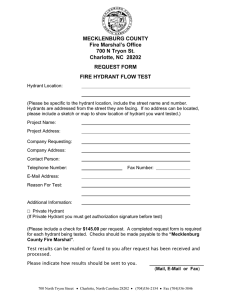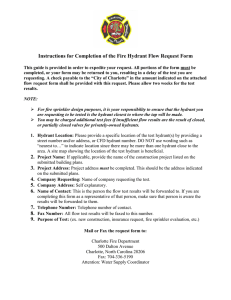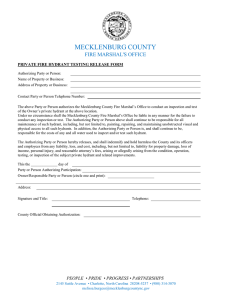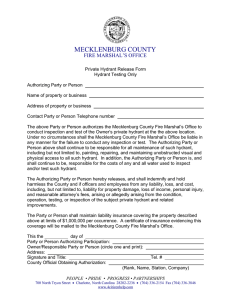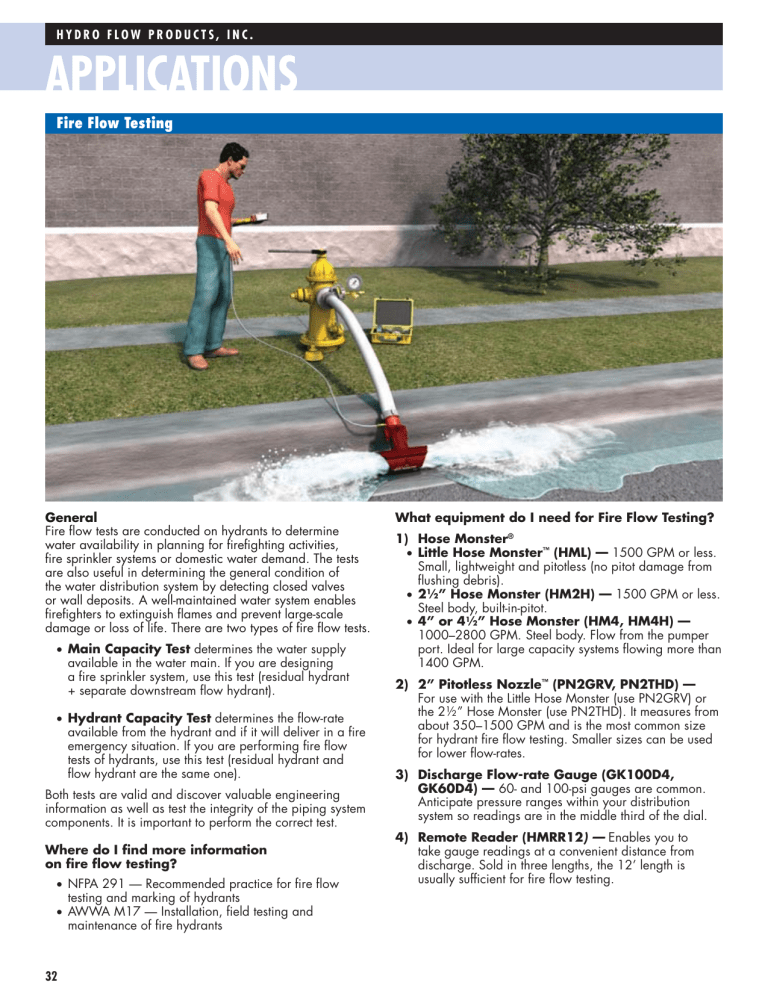
HYDRO FLOW PRODUCTS, INC. APPLICATIONS Fire Flow Testing General Fire flow tests are conducted on hydrants to determine water availability in planning for firefighting activities, fire sprinkler systems or domestic water demand. The tests are also useful in determining the general condition of the water distribution system by detecting closed valves or wall deposits. A well-maintained water system enables firefighters to extinguish flames and prevent large-scale damage or loss of life. There are two types of fire flow tests. v Main Capacity Test determines the water supply available in the water main. If you are designing a fire sprinkler system, use this test (residual hydrant + separate downstream flow hydrant). v Hydrant Capacity Test determines the flow-rate available from the hydrant and if it will deliver in a fire emergency situation. If you are performing fire flow tests of hydrants, use this test (residual hydrant and flow hydrant are the same one). Both tests are valid and discover valuable engineering information as well as test the integrity of the piping system components. It is important to perform the correct test. Where do I find more information on fire flow testing? v NFPA 291 — Recommended practice for fire flow testing and marking of hydrants v AWWA M17 — Installation, field testing and maintenance of fire hydrants 32 What equipment do I need for Fire Flow Testing? 1) Hose Monster® v Little Hose Monster™ (HML) — 1500 GPM or less. Small, lightweight and pitotless (no pitot damage from flushing debris). v 21⁄2” Hose Monster (HM2H) — 1500 GPM or less. Steel body, built-in-pitot. v 4” or 41⁄2” Hose Monster (HM4, HM4H) — 1000–2800 GPM. Steel body. Flow from the pumper port. Ideal for large capacity systems flowing more than 1400 GPM. 2) 2” Pitotless Nozzle™ (PN2GRV, PN2THD) — For use with the Little Hose Monster (use PN2GRV) or the 2½” Hose Monster (use PN2THD). It measures from about 350–1500 GPM and is the most common size for hydrant fire flow testing. Smaller sizes can be used for lower flow-rates. 3) Discharge Flow-rate Gauge (GK100D4, GK60D4) — 60- and 100-psi gauges are common. Anticipate pressure ranges within your distribution system so readings are in the middle third of the dial. 4) Remote Reader (HMRR12) — Enables you to take gauge readings at a convenient distance from discharge. Sold in three lengths, the 12’ length is usually sufficient for fire flow testing. Ü Ü Ü° à i Ã Ì i À° V Ê U Ê 1 - 8 8 8 - 2 0 2 - 9 9 8 7 APPLICATIONS Fire Flow Testing (Continued) 5) Test Hose (H2H.5, H2H.10RR, H4.5, H45.5) — v Length: For fire flow testing, 5’ or 10’ lengths are most common. v Options for attaching a hose to a hydrant: o Attach a 2½”-diameter hose to the pumper port by using a reducer. This is our preferred option because it enables a Little Hose Monster™ or 2½” Hose Monster® to be used from the pumper port and usually positions discharge directly in street gutter. o Attach a 2½”-diameter hose to the nozzle port of the hydrant. The hydrant nozzle ports are usually located on the sides of the hydrant and parallel to the street. A 10’ hose with a slight arc out of the nozzle port should discharge water in a street gutter. o Attach a 4” or 4½” hose to the pumper port of the hydrant. The pumper port of a hydrant is usually positioned so a 5’ hose out of the pumper port should position discharge directly in street gutter. This is usually used with a 4” or 4½” Hose Monster, but can be used with the HML and HM2H if a reducer is attached to the end of the hose. 6) Hydrant Gate Valve (HGV25, HGV4, HGV45) — This enables greater control of the water flow and reduces stress and opportunities for water hammer when opening or closing hydrants. 7) Gauge Cap (GCSW) — This component collects static and residual pressure readings from a hydrant in a fire flow test. It attaches to the 2½” NST nozzle port on the residual hydrant. 8) Static/Residual Pressure Gauges (GK160D4, GK100D4) — 100- or 160-psi gauges are most common. Anticipate pressure ranges within your distribution system so readings are in the middle third of the dial. 9) Hydrant Wrench (HW107) — Enables you to unscrew caps and open a hydrant to flow water. 10) Spanner Wrench (WSPA101, WSPA104) — v Spanner Wrench (WSPA101) attaches a hose to a hydrant or Pitotless Nozzle™ v Pitotless Nozzle Wrench (WSPA 104) attaches a Pitotless Nozzle to a 2½” Hose Monster (HM2H or HM2HF) 13) Gauge Case (CASE520, CASE720, CASE920) — Foam-padded cases keep gauges and Pitotless Nozzles protected and prevent damage. 14) Software (IMS, FFT) — v Infrastructure Management Systems collects critical data and provides detailed reports to manage your water distribution systems. IMS does all the calculations for you and provides reports and graphs that are unmatched for accuracy and details. It will automatically grade your fire hydrant capabilities per the NFPA recommendations. v Fire Flow Tester™ Software helps you perform fire flow tests to determine water availability for fire sprinkler systems, fire fighting, city planning and to achieve favorable ISO ratings. FFT produces useful reports that calculate predicted flow-rates and gives other useful information like the NFPA class and color code for each hydrant tested. 15) Gauge Calibration (GCC2H, GCC4) — For fire flow testing, NFPA recommends test gauges be calibrated within 12 months prior to the test. We offer gauge calibration for new and used gauges that ensures accuracy. It comes with a NIST certificate. 16) Stream Shaper (SS1) — For high-pressure flowrates, used to prevent hose burn. 17) 45° or 30° Test Header Elbow (EL452HNH, EL302HNH) — Enables the hose to be angled differently and positions the discharge water in a different area. Terminology Flow Hydrant — The hydrant that flows water and measures the test flow-rate. Hydrant Capacity Test — A type of fire flow test that evaluates the water supply available from the hydrant. Main Capacity Test — A type of fire flow test that evaluates the water supply of the fire main at the location of the residual hydrant. Nozzle Pressure — The pressure measured at a nozzle in a fire flow or fire pump test. It can describe the Pitotless Nozzle, hydrant nozzle or the orifice on the Hose Monster. Nozzle pressure, pitot pressure and velocity pressure are often used interchangeably. Rated Capacity — The water supply available at a specified residual pressure (usually 20 psi). Also consider: 11) Dechlor Demon™ (DD2H, DD4, DD4H) — Designed for dechlorinating discharge water while flow testing without affecting flow-rate measurements. Contact your local authority having jurisdiction for more information when dealing with super-chlorinated water mains or discharging near lakes or rivers. Residual Hydrant — Also known as Test Hydrant. In a fire flow test, this hydrant measures static and residual pressures. Test results apply to this hydrant. 12) Reducer Adapter (AD4.25, AD45.25) — Enables a 2½” hose to be flowed from the pumper port of a hydrant so that a Little Hose Monster or a 2½” Hose Monster can be used. Test Flow-rate — The flow-rate of water that is discharged in a fire flow or fire pump test. Residual Pressure — The pressure residing in the water distribution system when flowing in a fire flow test or any other actual flowing condition. Static Pressure — Water distribution system pressure at zero test flow. Test Hydrant — Also known as Residual Hydrant. In a fire flow test, this hydrant measures static and residual pressures. Test results apply to this hydrant. 33 HYDRO FLOW PRODUCTS, INC. APPLICATIONS Fire Flow Testing (Continued) Hydrant Capacity Flow Test Single-hydrant flow test The Hydrant Capacity Test evaluates the water supply available from the hydrant. The information derived from this test is used by the fire service to plan for fighting fires. If all hydrants in a system are tested, partially closed valves and other obstructions will become known. This test uses a single hydrant as both the test hydrant and the flow hydrant. Nozzle Pressure Static/Residual Gauge Evaluates water available at this point in the system. Setup At the test hydrant (pressure hydrant, static/residual hydrant): 1. Attach gauge cap. 2. Attach hydrant slow-close gate valve and tighten all other caps. 3. Set the Little Hose Monster™ with Pitotless Nozzle™ in an appropriate location for flowing water. 4. Attach hose to Pitotless Nozzle and Little Hose Monster assembly. 5. Attach Remote Reader assembly and gauge to Pitotless Nozzle. Test Hydrant and Flow Hydrant Conduct the test 1. Slowly open the hydrant using the gauge cap to purge air from the hydrant. Close it when air is vented. Fire Main 2. Record static pressure from gauge cap. 3. Slowly open hydrant gate valve to desired flow-rate (usually full open). 4. When the flow-rate stabilizes, a. Record nozzle pressure from the remote reader. and at the same moment b. Record the residual pressure reading from the gauge cap. At this point, the test is complete. 34 5. Slowly close gate valve, then close the hydrant. Remove test equipment from hydrant. Replace and tighten cap. If the hydrant is a dry barrel type, note that water drains properly from the hydrant. Remove Remote Reader and gauge from the Pitotless Nozzle. 6. Record the number of minutes that water was flowing. This can be used to account for the amount of water used during the flow test. The information collected from this test can be used to predict flow-rates and residual pressures. IMS™ and Fire Flow Tester™ are software packages for managing water distribution systems and conducting fire flow tests. Ü Ü Ü° à i Ã Ì i À° V Ê U Ê 1 - 8 8 8 - 2 0 2 - 9 9 8 7 APPLICATIONS Fire Flow Testing (Continued) Main Capacity Flow Test Two-hydrant flow test A Main Capacity Test evaluates the water supply of the fire main at the location of the test hydrant. The information derived from this test is used by city planners and contractors to consider the water supply for general use and fire sprinkler systems. Static/Residual Gauge Setup At the test hydrant (pressure hydrant, static/residual hydrant): 1. Attach gauge cap to test hydrant. Tighten all other caps. 2. Open test hydrant, vent air from hydrant body through the valve on the gauge cap assembly. Close it when air is vented. Residual Hydrant Nozzle Pressure Flow Hydrant At the flow hydrant 1. Set the Little Hose Monster™ with gauge to the Pitotless Nozzle™ in an appropriate location for flowing water. Evaluates water available at this point in the system. Main 2. Attach Remote Reader and gauge to the Pitotless Nozzle. Fire 3. Attach hydrant gate valve to the hydrant and close the gate valve. 4. Tighten other caps. 5. Attach the hose to the Pitotless Nozzle and Little Hose Monster assembly. Conduct the test 1. Record static pressure reading from gauge cap. 2. Slowly open hydrant using the gate valve to purge air from the hydrant. When hydrant is full of water, open gate valve to desired flow-rate (usually full open). 3. When the flow-rate stabilizes, a. Record nozzle pressure from the remote reader. and at the same moment At the test hydrant b. Record the residual pressure reading from the gauge cap. At this point, the test is complete. 4. Slowly close gate valve on flow hydrant, then close the hydrant. Remove test equipment from hydrant. Replace and tighten cap. If the hydrant is a dry barrel type, note that water drains properly from the hydrant. 5. Record the number of minutes that water was flowing. This can be used to account for the amount of water used during the flow test. At the test hydrant 6. Close the hydrant. Remove gauge cap and replace hydrant cap. If the hydrant is a dry barrel type, note that water drains properly from the hydrant. The information collected from this test can be used to predict flow-rates and residual pressures. IMS™ and Fire Flow Tester™ are software packages for managing water distribution systems and conducting fire flow tests. 35 HYDRO FLOW PRODUCTS, INC. APPLICATIONS Fire Flow Testing (Continued) How much is the friction loss when I use a hose? There is friction loss when flowing through a hose, but in a fire flow test, it doesn’t matter. The purpose of a fire flow test is to evaluate the water supply, or the flow-rate that will be available when the system is brought down to 20 psi residual. A fire flow test requires three measurements: static pressure, residual pressure and test flow-rate. The reading from the gauge cap on the residual hydrant gives you static pressure and residual pressure. The Pitotless Nozzle™ or Hose Monster® gives you the test flow-rate. Test #1 The friction loss created in the hose results in a lower test flow-rate and a greater residual pressure. This will not affect the predicted flow at 20 psi as long as there is a sufficient drop in static-to-residual pressure. NFPA 291, 4.3.6, 2010 recommends a drop of at least 25% from static to residual pressure. AWWA M17 recommends a drop of at least 10 PSI from static to residual pressure. To illustrate that friction loss does not have an effect on the predicted flow-rate: 1) Test #1 measures the test flow through an open hydrant nozzle with a hand-held pitot. v Static 85 psi v Residual 60 psi v Pitot 36 psi v Test flow 1007 GPM Predicted flow at 20 psi = 1687 GPM 2) Test #2 measures the test flow through 2½” x 10’ hose and the 2½” Hose Monster. v Static 85 psi v Residual 70 psi v Pitot 20 psi v Test flow 764 GPM UÊÊ /iÃÌÊyÜÊÊ/iÃÌÊÓÊÃÊiÃÃÊÌ >ÊÊ/iÃÌÊ£Ê because of the friction loss in 10’ of hose. P r e s s u r e UÊÊ ,iÃ`Õ>Ê«ÀiÃÃÕÀiÊÊ/iÃÌÊÓÊÃÊ}Ài>ÌiÀÊ Ì >ÊÊ/iÃÌÊ£°Ê/ iÊvÀVÌÊÃÃÊÊÌ iÊ ÃiÊ causes a backpressure which increases P S residual pressure. The higher residual I pressure compensates for the lower test flow-rate. 36 UÊÊ Ì ÊyÜÊÌiÃÌÃÊÀiÃÕÌÊÊ>Ê«Ài`VÌi`ÊyÜÊ>ÌÊÓäÊ*-ÊÌ >ÌÊÃÊ equal. Test points from both tests fall on the same line of the graph. In summary, the test flows will be different, but the difference will not affect the flow test. The Hose Monster and hose will result in a lower test flow-rate and a higher residual pressure. When all data is considered, the flow tests result in the same predicted flow-rates. Flow Graph Predicted flow at 20 psi = 1687 GPM UÊÊ -Ì>ÌVÊ«ÀiÃÃÕÀiÊÃÊiµÕ>ÊÊLÌ ÊÌiÃÌÃ°Ê Flow test equipment does not affect static pressure. Test #2 90 80 70 60 50 40 30 20 10 0 Test #2 Test #1 70 Predicted flow the same 60 20 764 1007 Flow-rate GPM 1687
